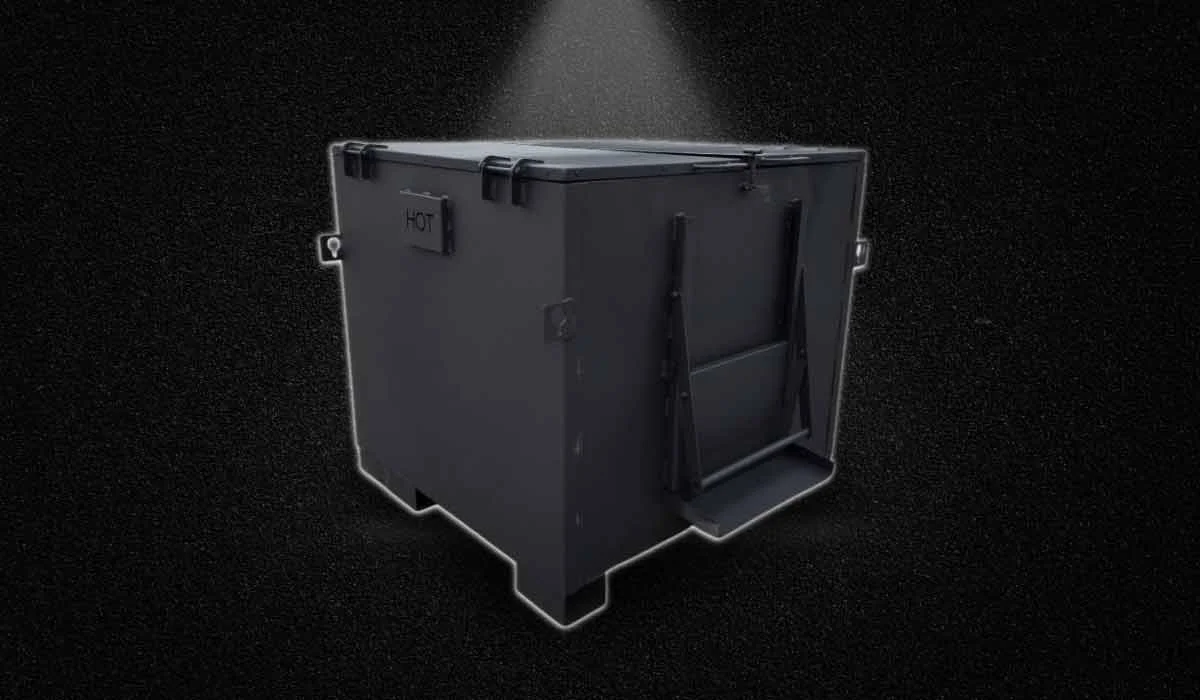- Patching a pothole is easier and more efficient with the help of an asphalt patching machine.
- Contractors can choose from infrared asphalt heaters, spray injection machines, and hot mix asphalt patching machines.
- If you're a contractor who patches potholes all year round, then it's best to invest in your own asphalt heating machine.
There are two ways to fix a pothole. The first solution is to apply a cold asphalt patch to the affected area and compact it to produce a smooth and even surface.
It's quick and easy, but this is largely a temporary fix. Using an asphalt patching machine is a better option for those who want a more long-lasting solution.
In this blog, you'll learn how this machine works, how it can make the asphalt patching process more efficient, and the mechanism behind it. If you're looking for an infrared asphalt heater for sale, but you want to learn more about this amazing machine before you order one, then read on!
Table of Contents
- What are Asphalt Patching Machines?
- The Important Role the Machine Plays in Driveway and Parking Lot Maintenance
- Different Types of Asphalt Patching Machines
- How Do Infrared Asphalt Patching Machines Work?
- Why Patching Potholes with an Infrared Heater Stands Out
- Why Use Asphalt Patching Machines?
- Infrared Asphalt Patching and Other Methods
- Collaborative Repairs in Varied Climates
- Is it Better to Rent a Hot Patch Asphalt Machine or Own One?
- Proper Equipment Maintenance
- Safety Precautions for Operating Asphalt Patching Machines
- Environmental Considerations
- Asphalt Heating Machine FAQs
Asphalt Patching Machines: An Overview
Asphalt patching machines are designed to repair and restore damaged sections of asphalt through heating or by adding millings directly into the area. It is used in pothole patching, as well as for fixing cracked sections of an asphalt pavement.
Infrared heating machines, in particular, prepare the area for the new material by softening the asphalt with heat. This allows the worker to lay down a fresh layer of asphalt, seamlessly blending with the surrounding area.
This process isn't just about filling a pothole. It's about ensuring longevity and durability in pothole repair, guaranteeing that the same spot won't be a problem in the near future.
Asphalt Patching Machines' Crucial Role in Parking Lot and Driveway Maintenance
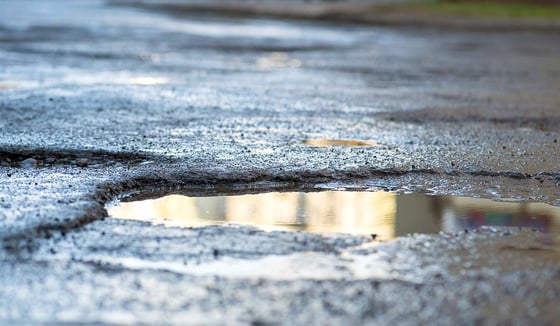 Asphalt patching machines are crucial for patching parking lots and driveways
Asphalt patching machines are crucial for patching parking lots and driveways
Parking lots and driveways are often the first points of contact for businesses and homes. They are subjected to constant wear and tear from vehicles, weather changes, and other external factors. Over time, this wear results in cracks, divots, and the dreaded potholes.
Here's where asphalt patching machines come in.
These machines cut the pothole repair process in half thanks to its fast heating. With this piece of equipment, asphalt repair is less time-consuming and more efficient. In fact, a simple pothole patching can now take anywhere between 15 and 30 minutes.
Types of Asphalt Patching Machines
Pothole patching has seen various innovative machines emerge over the years. These machines offer different methods of operation tailored for specific applications.
Let’s explore the primary types and what sets each one apart.
Infrared Asphalt Patching Machines
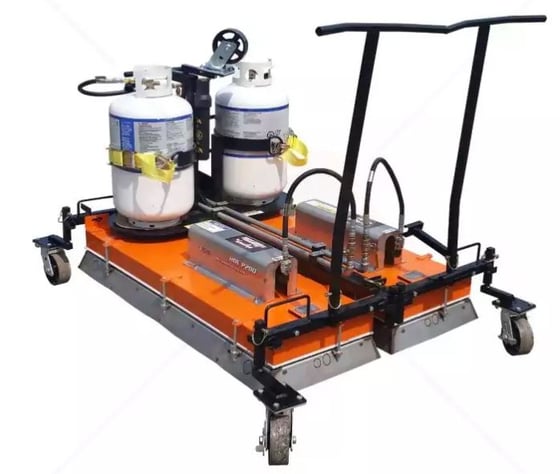 Asphalt Kingdom's Mini Infrared Asphalt Heater
Asphalt Kingdom's Mini Infrared Asphalt Heater
Method of Operation: These machines use infrared rays to heat the damaged asphalt area, making it soft and workable. A mix of the existing softened asphalt with new material (asphalt millings) is applied before compaction.
The Mini Infrared Asphalt Heater is good example of a compact asphalt patching machine. Don't let its small size fool you. This powerful piece of equipment heats damaged asphalt in 7 minutes or less, allowing you to fix more potholes in one day.
Application: Ideal for smaller areas with surface-level imperfections such as potholes, cracks, and seams. It offers a seamless finish and is especially suitable for places where aesthetics are crucial, like parking lots and driveways.
Spray Injection Patching Machines
Method of Operation: Using force, this machine sprays a mixture of asphalt emulsion and aggregate directly into the pothole or crack. It is then compacted using a roller or plate compactor.
Application: Best for deeper potholes and wide cracks, especially in high-traffic areas. The process is quick, reduces disruption, and offers a long-lasting repair.
Hot Mix Asphalt Patching Machines
Method of Operation: These machines transport and apply hot mix asphalt (HMA) directly to the area in need of repair. The hot mix is then spread evenly and compacted.
Application: HMA patching is typically used for larger areas in need of repair or resurfacing. It's the method of choice for most road repair projects as the pavement becomes more durable and resilient.
Mechanical Patcher and Paver Machines
Method of Operation: These machines are equipped with a mechanical arm or conveyor system to apply asphalt patches. They can handle both hot and cold mixes, spreading them evenly over the damaged area.
Application: Ideal for extensive road repairs or when patching long stretches of cracks or damaged sections. They are efficient and provide consistent results over large areas.
Related: The Best Material to Fill Potholes (+ How to Fix Potholes)
The Mechanism Behind Infrared Asphalt Patching Machines
Infrared asphalt patching is a cutting-edge technique that offers an efficient and durable solution to different asphalt problems.
But what sets infrared machines apart from traditional patching methods, and how exactly do they work? Let's delve into the fascinating world of infrared technology in asphalt repair.
The Science Behind Infrared Heating
Infrared asphalt patching machines use infrared rays, a form of electromagnetic radiation, to heat the area of asphalt that needs repair. These rays penetrate deep into the asphalt, heating it uniformly. This process softens the asphalt, making it pliable and workable, almost like it was freshly laid.
The Pothole Repair Process
Step 1: Heating the asphalt
The machine is positioned over the damaged area, and infrared rays are emitted to heat the asphalt. This heating process typically takes between 5 to 10 minutes, depending on the depth and extent of the damage.
Step 2: Reworking the damaged section
Once the asphalt has softened, the damaged or deteriorated portion can be easily raked out.
Step 3: Applying fresh material
Next, add some hot asphalt millings to fill the pothole. This ensures a seamless blend with the surrounding material. Spritz some asphalt millings rejuvenator to restores asphalt's lost oils and improve its adhesion.
Step 4: Compacting the section
The final step involves compacting the patched area with an asphalt roller or a plate compactor. Proper compaction ensures that the repaired section is level with the surrounding surface and offers optimal durability.
This is just an overview on the pothole repair process. If you want to delve deeper into the process, then check out the How to Fill a Pothole in 4 Steps blog post.
Why Infrared Asphalt Patching Stands Out
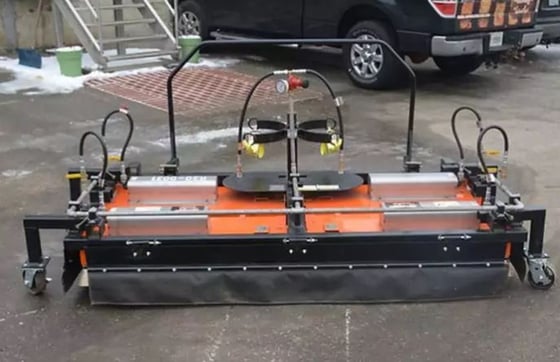 Parking lot repair with an infrared heater
Parking lot repair with an infrared heater
Infrared patching offers several advantages over traditional methods.
It's less invasive, meaning there's less cutting and removal of asphalt involved. This leads to seamless repairs that are both aesthetically pleasing and durable.
The process is also faster, allowing for quicker turnaround times and less disruption, especially in high-traffic parking lots.
This method allows you to reuse much of the existing asphalt. This makes the process a more environmentally friendly and cost-effective method.
Advantages of Asphalt Patching Machines
The evolution of road repair has been greatly enhanced with the advent of asphalt hot patch machines. These machines, with their advanced technology and precision, offer a lot of advantages that are reshaping the industry. Let's delve into the prominent benefits they offer.
Efficiency and Time-Saving Benefits
Traditional methods of asphalt patching often involved manual labor, which could be time-consuming and labor-intensive. Asphalt patching machines, on the other hand, streamline the repair process.
From heating the damaged area to applying the material and compacting it, these machines are designed for speed. This efficiency translates to faster repair times, enabling more areas to be serviced within the same timeframe.
Consistency and Quality of Repairs
Human error is a variable that can sometimes compromise the quality of parking lot repairs. Asphalt hot patch machines eliminate much of this inconsistency.
Whether it's the even distribution of material, the perfect temperature setting in infrared patcher, or the consistent compaction pressure, this machine ensures that each repair meets a high-quality standard.
Reduction in Traffic Disruptions
Driveway and parking lot repairs can be a major source of inconvenience for customers. Given the speed and efficiency of asphalt patching machines, the duration of parking and driveway closures or restrictions is significantly reduced.
This means fewer disruptions in busy areas, making the repair process less of a headache for for contractors and customers alike.
Safety Enhancements
Asphalt patch machines have built-in safety features that protect both the operators and the public. These can include temperature control and monitor, auto shut-off mechanism, heat shield, emergency stop button, and more.
By minimizing human interaction with the hot materials and the asphalt surface, the risk of injuries from burns or accidents is considerably reduced. Moreover, faster repairs mean less exposure time for workers on busy parking lots.
Economic Benefits
While the initial investment in these machines might be substantial, the long-term savings are undeniable. With quicker repairs, there's a reduction in labor hours and costs.
The consistent quality means fewer return visits for rework. Plus, the extended lifespan of the repairs means roads require less frequent attention.
Related: How to Patch Asphalt: 7 Important Tips
Combining Asphalt Patching Machines with Other Repair Methods
In asphalt maintenance, a holistic approach often yields the best results. While asphalt patching machines are revolutionary in their own right, integrating them with traditional repair techniques can amplify their effectiveness, leading to more robust and enduring solutions.
Enhancement of Overlay Projects
Overlaying involves applying a new layer of asphalt over the existing one. By first using asphalt patching machines to address significant defects, the overlay can be applied to a smoother, more consistent base.
This approach ensures that the new layer adheres better and reduces the chances of the old damages reflecting through.
Optimization of Milling and Resurfacing
Before a full milling and resurfacing project, addressing problematic zones with an asphalt patching machine can make the milling process smoother.
It ensures that the milled surface is consistent, leading to a more even resurfacing and ultimately a longer-lasting driveway and parking lot.
Boosting the Efficacy of Sealcoating
Sealcoating provides a protective layer against UV rays, water, and vehicular fluids.
By patching any damages with an asphalt patching machine before sealcoating, contractors can ensure a more even application. The uniform surface allows the sealcoat to adhere better, enhancing its protective qualities.
Enhanced Drainage Solutions
Proper drainage is essential to prolonging asphalt lifespan. After employing an asphalt patching machine, traditional methods like the installation of drains or the reshaping of surfaces can be used.
These combined approaches ensure water moves away efficiently, reducing the risk of asphalt damage due to standing water.
Collaborative Repairs in Varied Climates
Some traditional repair techniques might be better suited for specific climates. For instance, cold patching might be preferred in some colder regions.
Using asphalt patch machines in tandem with these region-specific methods ensures optimal results regardless of environmental challenges.
Renting vs. Buying Asphalt Patching Machines
Is it better to rent an asphalt infrared heater, or take the plunge and invest in owning one? Both options come with their own set of advantages and challenges. However, the long-term benefits of ownership certainly stand out.
Renting an Infrared Asphalt Heater: Pros and Cons
Pros
Short-Term Commitment. Ideal for one-off projects or those just starting in the business as renting doesn’t tie you down.
Lower Initial Costs. No significant upfront investment is required, making it budget-friendly for smaller operations.
Maintenance. Typically, the rental company handles machine maintenance, freeing you from added responsibilities.
Cons
Availability. Popular models might not always be available when needed, potentially causing project delays.
Cost Over Time. Regular rentals can quickly add up if you have a lot of clients, making it more expensive in the long run.
Lack of Customization. Renting doesn’t allow for machine customization or company branding, which can be vital for specialized projects.
Buying an Infrared Asphalt Heater: The Benefits
Always Accessible. Owning ensures that the machine is always at your disposal, allowing for flexibility in project scheduling.
Cost-effective in the Long Run. Though there's an initial investment, over time, the recurring costs of rentals will surpass the purchase price. Ownership becomes the more economical choice.
Customization and Upgrades. Owning allows you to modify or upgrade the machine based on specific project needs or as new technology emerges.
Builds Business Equity. The machine becomes a business asset. This can be advantageous for business valuations, securing loans, or even potential resale in the future.
Consistent Training and Expertise. With continuous access to the same machine, operators become more familiar and skilled, leading to faster and more efficient repairs.
Potential for Rental Income. If there are periods where you're not using the machine, it can be rented out to other contractors. This can provide you with an additional revenue stream.
Related: Make Money All Winter Long Doing Urgent Pothole Repair
Maintenance Practices for Asphalt Patching Machines
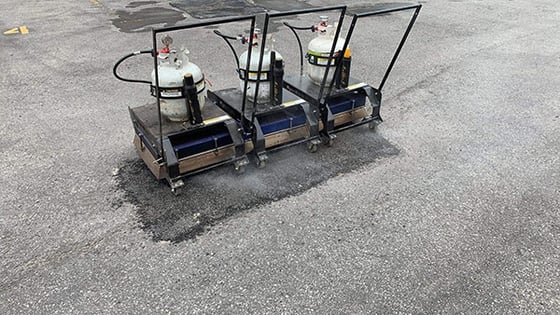 Multiple infrared asphalt heaters in action
Multiple infrared asphalt heaters in action
The effectiveness of an asphalt infrared heater, like any heavy machinery, hinges on its state of maintenance.
Regular upkeep not only prolongs the machine's lifespan, but also ensures peak performance.
Regular Maintenance Schedule: Building Consistency
Daily Checks. Before starting the machine each day, operators should inspect for visible damages, leaks, or obstructions. It's also crucial to check the propane tank and infrared emitters to ensure they're functioning correctly.
Weekly Inspections. Dedicate time each week to examine hoses, connections, and controls. This routine helps spot minor issues before they escalate.
Monthly Assessments. Every month, inspect the the hose and propane tank for leaks and ensure that all connectors are tight. It's also a good time to review the overall condition of the infrared panels, ensuring they distribute heat uniformly.
Annual Servicing. Once a year, it's advisable to have a comprehensive inspection and servicing. This might include replacing worn-out parts, recalibrating systems, and ensuring that all safety features are in top condition.
Essential Maintenance Tasks: Ensuring Peak Performance
Clean the Infrared Panels. The infrared panels should be kept clean to ensure uniform heat distribution. Any accumulated debris or residue can impact the machine's efficiency.
Check Fuel Levels and Quality. Running out of fuel during a job can be both inconvenient and harmful to the machine. Regularly monitor fuel levels and ensure the fuel's quality meets the manufacturer's specifications.
Monitor Temperature Controls. The temperature controls should be tested frequently to ensure they're accurate. Overheating or insufficient heating can affect the quality of the pothole repairs.
Inspect Safety Systems. Safety should never be compromised. Regularly check all safety features, including emergency shut-offs, regulators, and temperature gauges, to ensure they're operational.
Store the Machine Properly. When not in use, the machine should be stored in a dry, sheltered location to protect it from rain and snow.
Safety Precautions for Operating Asphalt Patching Machines
Asphalt patching, particularly with infrared heating machines, is a task that demands acute attention to safety. These machines, while remarkably effective, can also pose risks if not handled correctly.
Proper training, operator skills, and the right safety gear are crucial to ensuring accidents and injuries are kept at bay.
Proper Training and Operator Skills
Comprehensive Onboarding. Every operator should undergo thorough training before handling the machine. This training should encompass both theoretical knowledge and hands-on practice.
Regular Refresher Courses. Even seasoned operators can benefit from periodic refresher courses, updating them on the latest safety protocols and any modifications to machine operation.
Emergency Protocols. Operators should be well-versed in emergency shutdown procedures and know how to quickly disable the machine should a malfunction occur.
Understanding Machine Indicators. Recognizing the signs of a machine malfunction or an impending problem, such as warning lights or unusual noises, is important to your safety. Timely intervention can also prevent more severe issues.
Safety Gear: A Non-Negotiable Aspect

Caption: Heat-resistant work gloves
Use heat-resistant gloves. Given the high temperatures involved, operators should always wear heat-resistant gloves to protect their hands from burns.
Don't forget your safety eyewear. Protecting the eyes from any flying debris, heat radiations, or accidental splashes is essential. Safety goggles or glasses are a must.
Wear protective footwear. Sturdy work boots with heat and slip-resistant soles will protect feet and provide a better grip on the job site.
Don high-visibility clothing. High-visibility vests or jackets ensure operators are easily spotted by other crew members or drivers.
On-the-Job Precautions During Pothole Patching
Demarcate the work zone. Using traffic cones, barriers, or caution tape, clearly delineate the work area. This keeps unauthorized personnel out and alerts drivers or pedestrians to potential hazards.
Monitor environmental conditions. Rain or overly wet conditions can interfere with the machine's operations. It's crucial to check weather forecasts and be prepared to halt operations if necessary.
Stay hydrated. The heat radiating from the machine, the hot asphalt, and the sun beating down on you can quickly lead to dehydration. Drink water frequently and take breaks when needed.
Avoid direct contact with the machine. Never touch freshly heated asphalt or the machine's heating elements.
Make sure the area is well-ventilated. When operating in enclosed spaces, ensure proper ventilation. This helps dissipate any harmful fumes that may emanate during the heating process.
Store the infrared asphalt heater in a safe place. Post-operation, ensure the machine is turned off, cooled down, and stored safely. Keep it away from flammable materials or high-traffic areas.
Related: What is Asphalt Rejuvenation: A Comprehensive Guide
Environmental Considerations of Asphalt Patching Machines
 Pothole patching in the winter
Pothole patching in the winter
The use of asphalt patching machines brings to the fore certain environmental considerations. By incorporating a few proactive measures, contractors can ensure that their asphalt patching processes are as green as possible.
Environmental Impact of Asphalt Patching
Emissions
Traditional asphalt heating methods can release emissions that contribute to air pollution. Infrared asphalt heaters, while more efficient, still have some level of emissions.
Resource Consumption
The production of asphalt requires significant resources, including crude oil. Thus, any waste in the patching process can translate to wasted resources.
Waste Generation
Improper or inefficient patching can result in excess material being removed and discarded, leading to increased waste.
Minimizing Waste and Boosting Sustainability with Your Infrared Heater
Infrared Technology Efficiency
One of the advantages of infrared asphalt heaters is their ability to heat the asphalt uniformly, ensuring that only the necessary amount is softened for repair.
This reduces waste as compared to traditional methods that might necessitate removing more material than required.
Asphalt Recycling
One of the most sustainable practices in the industry is asphalt recycling. Reclaimed asphalt pavement (RAP) and hot asphalt millings can be incorporated into new mixtures, reducing the need for fresh materials.
Some modern patching machines even facilitate on-site recycling, allowing contractors to reuse the excavated asphalt immediately.
Temperature Monitoring
By maintaining optimal temperatures, operators can ensure that asphalt is neither overcooked (leading to degradation) nor undercooked (resulting in ineffective repairs).
Proper temperature control can reduce wastage and ensure the longevity of repairs.
Sustainable Material Sourcing
Contractors can prioritize using asphalt mixtures that incorporate recycled materials or are sourced sustainably. This not only reduces the environmental footprint but can also offer cost benefits.
Regular Machine Maintenance
A well-maintained machine operates more efficiently, minimizing resource wastage. It can also reduce the chances of accidental spills or leaks that could harm the environment.
Educate and Train
Providing regular training to operators about the importance of sustainable practices ensures that they are conscious about minimizing waste and following environmentally friendly procedures.
Green Innovations
As technology progresses, there are continuous innovations in asphalt production and repair that lean towards sustainability. Keeping abreast of these changes and adapting them can further minimize environmental impact.
Asphalt Patching Machines Frequently Asked Questions
Are asphalt patching machines suitable for both residential and commercial projects?
Yes, asphalt patching machines can be employed for both residential and commercial projects. Their versatility makes them ideal for everything from small driveway repairs in homes to large parking lots and roads in commercial areas.
How does the size and capacity of an asphalt patching machine affect its performance?
The size and capacity of an asphalt patching machine directly influence the area it can cover and the speed of the job. Larger machines can handle vast areas more quickly, making them ideal for large commercial projects.
In contrast, smaller machines offer more maneuverability and precision. These are perfect for tight spaces in residential areas or small potholes in commercial parking lots.
What safety precautions should operators take while using an asphalt patching machine?
Operators should always wear heat-resistant gloves, safety eyewear, protective footwear, and high-visibility clothing.
Additionally, they must be trained in emergency shutdown procedures and avoid direct contact with freshly heated asphalt. They should ensure proper ventilation in enclosed spaces and always demarcate the work zone to alert others of potential hazards.
Do asphalt patching machines require a specific skill level to operate effectively?
Yes, effective operation of asphalt patching machines demands both training and hands-on experience.
Operators should be familiar with the machine's controls, understand temperature monitoring, and be adept at handling any emergencies or malfunctions.
Can asphalt patching machines be used in combination with other repair methods?
Absolutely! Asphalt patching machines can be integrated with traditional repair techniques. Their versatility means they can complement other methods, enhancing the overall outcome and longevity of repairs.
How do climate and weather conditions impact the effectiveness of asphalt patching machines?
Weather conditions play a significant role in asphalt maintenance. Rain or overly wet conditions can hinder the pothole patching process, as moisture can prevent proper adhesion.
Extremely cold temperatures might also affect the machine's ability to heat the asphalt efficiently. It's always advisable to check weather forecasts and be prepared to adjust operations accordingly.
Can asphalt patching machines be used for pothole repairs as well as surface distresses?
Yes, these machines are designed to tackle a range of asphalt issues. They can effectively repair potholes, cracks, birdbaths, and various surface distresses.
Conclusion
Ready to purchase your first portable infrared asphalt heater? Get in touch with Asphalt Kingdom's equipment specialists at 1-866-399-5562 or send a message to sales@asphaltkingdom.com.





